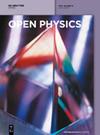Microscopic seepage simulation of gas and water in shale pores and slits based on VOF
IF 1.8
4区 物理与天体物理
Q2 PHYSICS, MULTIDISCIPLINARY
引用次数: 0
Abstract
The microscopic pore-fracture structure and wettability have a significant influence on the two-phase seepage of shale gas and water. Due to the limitation of experimental conditions, the seepage patterns of gas and water in shale pores and slits under different wetting conditions have not been clarified yet. In this study, the three-dimensional digital rock models of shale inorganic pores, organic pores, and microfractures are established by focused ion beam-scanning electron microscopy scanning, and gas-driven water seepage simulation in shale microscopic pore-fracture structure under different wetting conditions is carried out based on volume of fluid method. The simulation results show that the gas–water relative permeability curves of microfractures are up-concave, and the gas–water relative permeability curves of inorganic and organic pores are up-convex; the gas–water two-phase percolation in microfractures is least affected by the change of wettability, the gas–water two-phase percolation in inorganic pores is most affected by the change of wettability, and the organic pores are in between; the gas–water two-phase percolation zone of microfractures is the largest, and the isotonic saturation is the highest; under the water-wet conditions, the critical gas saturation of microfractures, inorganic pores, and organic pores are 0.13, 0.315, and 0.34, respectively, and the critical gas saturation of organic pores under non-water-wet conditions is 0.525, indicating that under water-bearing conditions, the shale gas flow capacity in water-wet microfractures is the strongest, followed by water-wet inorganic pores, water-wet organic pores, and hydrophobic organic pores, respectively.基于 VOF 的页岩孔隙和缝隙中气体和水的微观渗流模拟
微观孔隙裂缝结构和润湿性对页岩气水两相渗流具有重要影响。由于实验条件的限制,不同润湿条件下页岩孔隙和缝隙中气、水的渗流规律尚未明确。本研究通过聚焦离子束扫描电镜扫描建立了页岩无机孔隙、有机孔隙和微裂隙的三维数字岩石模型,并基于流体体积法对不同润湿条件下页岩微观孔隙-裂隙结构中气驱水渗流进行了模拟。模拟结果表明:微裂隙的气水相对渗透率曲线呈上凹型,无机孔隙和有机孔隙的气水相对渗透率曲线呈上凸型;微裂隙中气水两相渗流受润湿性变化的影响最小,无机孔隙中气水两相渗流受润湿性变化的影响最大,有机孔隙介于两者之间;微裂隙的气水两相渗流带最大,等渗饱和度最高;在水湿条件下,微裂隙、无机孔隙和有机孔隙的临界气体饱和度分别为 0.13、0.315和0.34,非水湿条件下有机孔隙的临界气体饱和度为0.525,说明在含水条件下,水湿微裂隙中页岩气流动能力最强,其次分别是水湿无机孔隙、水湿有机孔隙和疏水有机孔隙。
本文章由计算机程序翻译,如有差异,请以英文原文为准。
求助全文
约1分钟内获得全文
求助全文
来源期刊

Open Physics
PHYSICS, MULTIDISCIPLINARY-
CiteScore
3.20
自引率
5.30%
发文量
82
审稿时长
18 weeks
期刊介绍:
Open Physics is a peer-reviewed, open access, electronic journal devoted to the publication of fundamental research results in all fields of physics. The journal provides the readers with free, instant, and permanent access to all content worldwide; and the authors with extensive promotion of published articles, long-time preservation, language-correction services, no space constraints and immediate publication. Our standard policy requires each paper to be reviewed by at least two Referees and the peer-review process is single-blind.
 求助内容:
求助内容: 应助结果提醒方式:
应助结果提醒方式:


